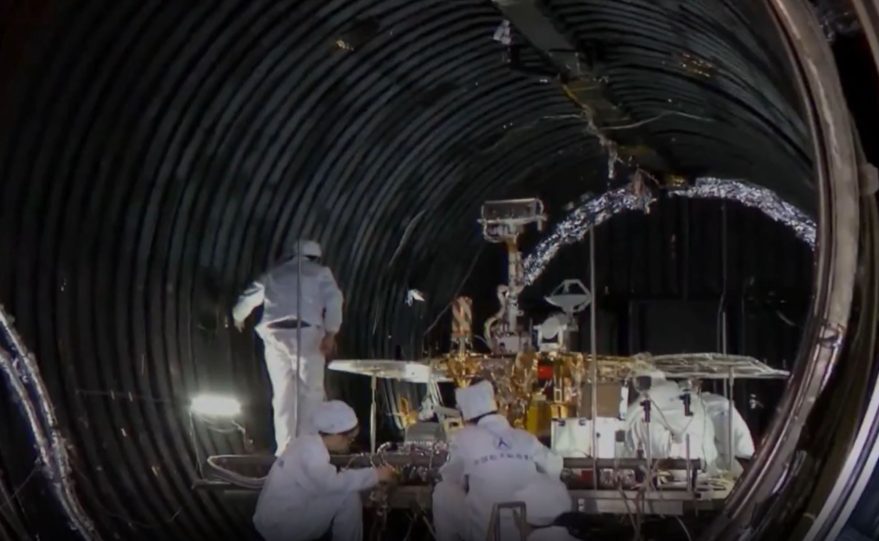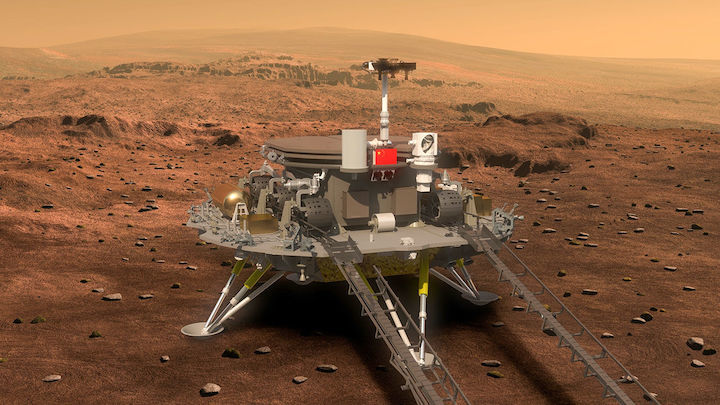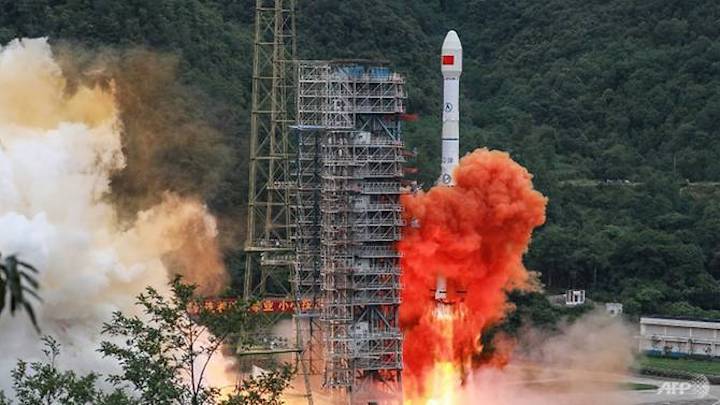With a five-meter-wide, 57-meter-tall rocket waiting to blast off from China’s southern island of Hainan, the nation is quietly making final preparations for its first independent trip to Mars. When the launch window opens in mid-July, Chinese scientists will strive to send a probe to a planet that confused their ancestors with its constantly changing brightness and position in the sky.
The spacecraft, called Tianwen-1, or the “Quest for Heavenly Truth,” will carry 13 scientific instruments to examine the Red Planet from orbit and on its surface. Tianwen-1 will examine how water ice is distributed on Mars, as well as the planet’s physical evolution and its habitability over time. The mission—consisting of an orbiter, lander, and rover—is “the most ambitious thing one could do on a first attempt,” says John Logsdon, a space policy expert at George Washington University.
TROUBLING TRACK RECORD
The odds of a flawless mission are daunting: Of humanity’s dozens of attempts to orbit or land on Mars to date, only about half have succeeded. After some high-profile setbacks, NASA has deployed five landers, four rovers and multiple orbiters that have brought the world to life for scientists and the public alike. But China’s spacefaring experience beyond Earth orbit has been limited to several robotic moon missions and an orbiter that piggybacked on a failed Russian mission to the Martian moon Phobos in 2011.
Two major risks confront the five-metric-ton Tianwen-1, Logsdon says. First, China’s most powerful heavy-lift rocket, Long March 5, has only launched three times—including a major failure in 2017, when the rocket started to malfunction shortly after takeoff. It took more than two years for scientists to fix Long March 5’s core-stage-engine problem and score a successful flight in late 2019. Its track record makes observers nervous, however.
Second, Tianwen-1’s lander must navigate the challenging Martian atmosphere, which is thick enough to overheat the probe but too thin to decelerate it sufficiently. The spacecraft’s entry, descent and landing technology uses a heat shield, a parachute and a retro-engine to slow its descent, an arrangement resembling that of earlier U.S. missions. Yet when the vessel is just 100 meters above the surface, it will pause, take snapshots of the area and quickly calculate the best landing spot. Then it will shift horizontally to center above that spot and carefully touch down with the lander’s four legs.
In November 2019 China tested this part of the landing procedure, which the nation had previously used successfully in its moon landings, in the province of Hebei. Foreign officials were invited to watch the test on-site. It was the last major public event for Tianwen-1, however. Since then, the China National Space Administration (CNSA) has kept a low profile, and mission scientists have declined or ignored nearly all interview requests.
SCIENTIFIC OPPORTUNITIES
Should Tianwen-1 land successfully, its research could illuminate new aspects of Mars. For instance, both the orbiter and the rover are equipped with a ground-penetrating radar to chart geologic layers under the surface. The radar on the orbiter can “see” as deep as a few thousand meters, whereas the instrument on the rover has a shallower view but sharp centimeter-level resolution. “China’s main goal [with these radars] is to explore the water-ice layer” under the planet’s surface, says Wlodek Kofman of the Institute for Planetary Sciences and Astrophysics of Grenoble in France.
Tianwen-1’s ability to measure Mars’s magnetic field excites Jim Bell of Arizona State University, principal investigator of the main camera on NASA’s Perseverance rover. One prevailing hypothesis is that the Red Planet used to have a global magnetic field like Earth's, he says. When its smaller molten iron core cooled down, however, Mars gradually lost this shield, exposing the world to solar wind and radiation, thinning its atmosphere and dooming any water that might have flowed on its surface. Since 2014 NASA’s Mars Atmosphere and Volatile Evolution (MAVEN) mission has found ample evidence to support this scenario, but scientists crave a fuller picture. “Tianwen-1 will be very useful in providing more evidence from a different orbit and from the ground,” Bell says. He hopes the Chinese team will share data with the international community piecing together the environmental evolution of Mars.
Tianwen-1 will aim to land in the southern part of Utopia Planitia, a largely flat area between 25 and 30 degrees north of the Martian equator. Geologists have long suspected that this region is covered with ancient mudflows, pointing to stores of bygone water. “It’s an interesting place to investigate potential past subsurface habitability,” says Alfred McEwen, a planetary geologist at the University of Arizona.
FIRST IN A SERIES
The rover’s chance of finding water beneath Mars might be limited by its latitude, McEwen notes. Because it draws its power from solar panels, it must stay near the equator. Today water ice below the planet’s surface, most researchers believe, remains mainly at higher and cooler latitudes.
Tianwen-1’s reliance on the sun compelled its team to design hardy instruments, says Rong Shu of the Shanghai Institute of Technical Physics at the Chinese Academy of Sciences. “Since our rover does not have radioisotope power, all the instruments need to endure temperatures as low as –90 degrees Celsius while at rest, and they operate in the temperature range of –40 to –30 degrees C,” he adds.
The rover's payload includes the Martian Surface Component Detector (MarSCoDe), whose design was led by Shu. Similar to ChemCam on NASA’s Curiosity rover, MarSCoDe can fire short laser pulses to vaporize the surfaces of rocks from a few meters away. The instrument will “sniff” the ionized gas produced by these mini blasts and determine the type and quantity of chemical elements in the rocks.
Tianwen-1 is expected to reach Mars in February 2021. It will spend about two months in a parking orbit, waiting for the best timing and surface conditions to land. China’s expanding radio telescope network of tracking and receiving stations will sustain communications between Earth and the probe.
Already, Chinese scientists are preparing for more missions in the Tianwen series, including ventures to return rock samples from Mars and an asteroid, to perform a flyby of Jupiter and to explore the margins of the sun’s vast heliosphere. But if Tianwen-1 reaches Mars as planned, Logsdon says, “it will put China in the space exploration business in a big way.”
Quelle: SCIENTIFIC AMERICAN
----
Update: 18.07.2020
.
Long March 5 rolled out for July 23 launch of China’s Tianwen-1 Mars mission

HELSINKI — China is preparing to launch its Tianwen-1 Mars orbiter and rover next week with the rollout of the mission’s Long March 5 launch vehicle.
The roughly 878-metric-ton heavy-lift Long March 5 was vertically transferred to its launch area at the coastal Wenchang Satellite Launch Center late Thursday Eastern.
The rollout indicates that China will launch Tianwen-1, the country’s first independent interplanetary mission, next week.
Final examinations and tests will be conducted before the launch, according to Chinese media. No launch date was announced, instead reports stated liftoff will take place between late July and early August.
Previous Long March 5 launches have seen a six-day period between rollout and launch. This suggests the launch will occur around July 23.
If successful the spacecraft will arrive at Mars in February 2021. The rover, inside an entry vehicle atop the orbiter, will remain attached to the orbiter in Mars orbit for 2-3 months before the landing attempt, a paper published in Nature this week confirms.
“The vertical transport of the rocket to the launching area has shown that we have made good preparations for the launching mission. We will stick to the strict and careful working attitude in the coming days,” Ge Xiaochun, chief engineer at the China National Space Administration, told Chinese media.
“The Mars probe is the first step of China’s planetary exploration project. The coming launching mission has been highly recognized and supported by the international community. We hope to contribute Chinese wisdom, ideas and solutions to the world for peaceful use of the space,” Ge said.
Tianwen-1 orbiter and rover
The Tianwen-1 orbiter carries seven science payloads. It is equipped with a high-resolution camera comparable to HiRise on board NASA’s Mars Reconnaissance Orbiter. It also carries a medium-resolution camera, subsurface radar, mineralogy spectrometer, neutral and energetic particle analyzers and a magnetometer. The orbiter, designed to operate for one Mars year, or 687 Earth days, will also play a relay role for the mission rover.
The roughly 240-kilogram solar-powered rover is nearly twice the mass of China’s ‘Yutu’ lunar rovers. It will carry a ground-penetrating radar, multispectral camera and a Laser Induced Breakdown Spectroscopy instrument. Other payloads will analyze the climate and magnetic environment. The rover will attempt to land in a southern section of Utopia Planitia where it is designed to operate for 90 Mars days.
The Institute for Space Research of the Austrian Academy of Sciences assisted in the development of the orbiter’s magnetometer. The L’Institut de Recherche en Astrophysique et Planétologie under French space agency CNES was involved in the Laser Induced Breakdown Spectroscopy instrument. Additionally, the European Space Agency’s Estrack ground stations will provide support during the early launch phase. Argentina space agency CONAE also has an unspecified role, according to logos present on the payload fairing.

Long March 5
The Long March 5 was delivered on a roughly 30 by 20-meter launch platform, with a 70-meter-tall umbilical tower. Rollout from the assembly building to the launch area took two hours.
This will be the fourth Long March 5 mission. The second, in July 2017, failed due to an issue with the rocket’s first stage engines. The launcher was subsequently grounded for over 900 days while the issue was being isolated and addressed. The third mission in December 2019 was a high-stakes return-to-flight, success of which cleared the way for the Tianwen-1 launch.
The Long March 5 is part of a new generation of Chinese launch vehicles which use combinations of liquid hydrogen or kerosene fuel with liquid oxygen. These both expand China’s launch capabilities but could also eventually replace the older, hypergolic Long March rockets.
The 5-meter-diameter Long March 5 core stage is powered by two YF-77 hydrolox engines. Each of four 3.35-meter-diameter side boosters are powered by a pair YF-100 kerolox engines.
The Long March 5 is capable of delivering 14 metric tons to geostationary transfer orbit, 8.2 tons to trans-lunar injection, or 6 tons to trans-Mars injection. Tianwen-1 has a mass of around 5 tons.
The fifth Long March 5 is expected to launch the Chang’e-5 lunar sample return late this year. The second launch of the Long March 5B, a variant for LEO launches, will then launch the core module of the Chinese Space Station as soon as early 2021.
Quelle: SN
+++
China prepares to launch Long March-5 rocket for Mars mission

Photo taken on July 17, 2020 shows the Long March-5 rocket at the Wenchang Space Launch Center in south China's Hainan Province. The Long March-5 rocket, to be used to launch China's first Mars exploration mission, was vertically transported to the launching area at the Wenchang Space Launch Center in south China's Hainan Province on Friday. The carrier rocket, coded as Long March-5 Y4, is planned to be launched in late July or early August, according to the China National Space Administration. (Photo by Zhang Gaoxiang/Xinhua)
The fourth Long March-5 rocket, to be used to launch China's first Mars exploration mission, was vertically transported to the launching area at the Wenchang Space Launch Center in south China's Hainan Province on Friday.
The carrier rocket, coded as Long March-5 Y4, is planned to be launched in late July or early August, according to the China National Space Administration.
Space engineers have conducted a general assembly and tests on the rocket, after it was transported to Wenchang at the end of May.
It took about two hours to vertically transport the large rocket to the launching area of the center Friday morning. Final examinations and tests will be conducted on the rocket before the launch.
This is the first time the Long March-5 carrier rocket, currently China's largest launch vehicle, to be put into practical use after three experimental launches. The rocket is expected to send the Mars probe into the Earth-Mars transfer orbit, which is also the first such mission to be carried out by China's carrier rocket.
China's first Mars exploration mission Tianwen-1 aims to complete orbiting, landing and roving in one mission, and to obtain scientific exploration data on Mars. Enditem

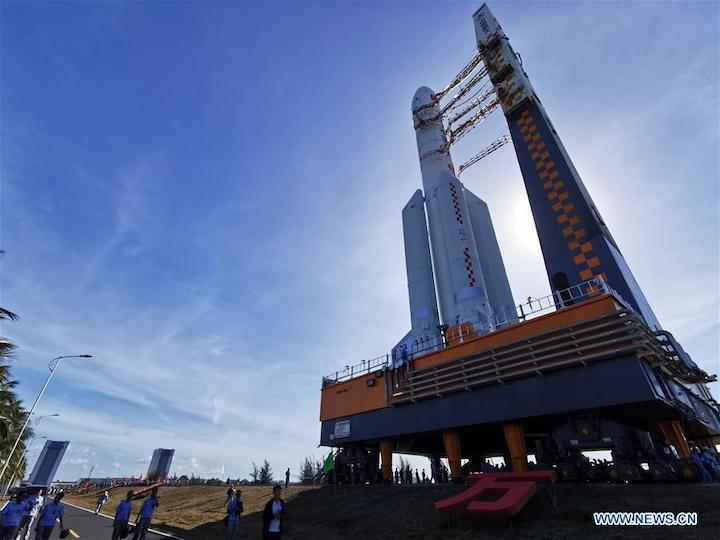


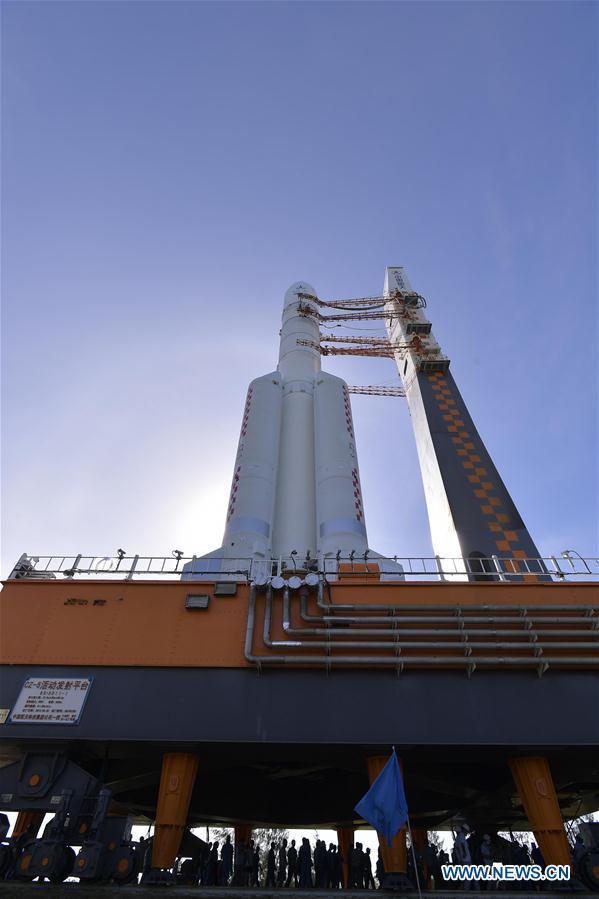
Quelle: Xinhua
----
Update: 21.07.2020
.
China prepares two relay satellites for Mars mission
China has completed the modification of two relay satellites to prepare them for new tasks relating to the country's scheduled Mars exploration mission Tianwen-1.
The Tianlian I-02 and Tianlian II-01 geosynchronous orbit satellites mainly provide global tracking and data-relay support for the country's in-orbit spacecraft.
The fourth Long March-5 rocket, which will be used to launch China's first Mars exploration mission, was transported to the launch site at the Wenchang Space Launch Center in south China's Hainan Province on July 17.
The carrier rocket, coded as Long March-5 Y4, is planned to be launched in late July or early August. Enditem
Quelle: Xinhua
----
Update: 23.07.2020
.
China launches ambitious attempt to land rover on Mars
China has launched its most ambitious Mars mission yet in an attempt to join the United States in successfully landing a spacecraft on the red planet
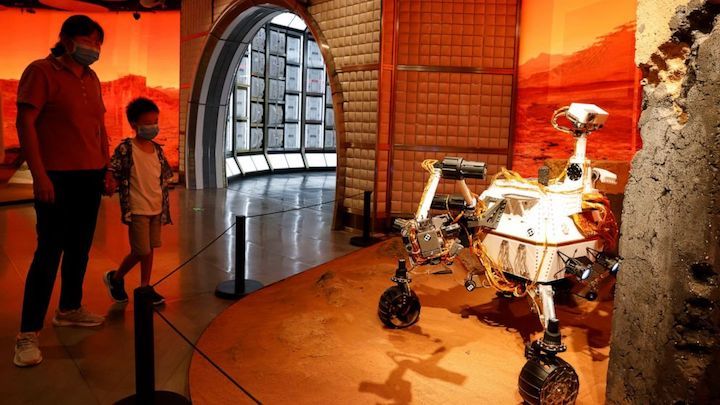
BEIJING -- China launched its most ambitious Mars mission yet on Thursday in a bold attempt to join the United States in successfully landing a spacecraft on the red planet.
Engines blazing orange, a Long March-5 carrier rocket took off under clear skies around 12:40 p.m. from Hainan Island, south of China's mainland. Hundreds of space enthusiasts cried out excitedly on a beach across the bay from the launch site.
“This is a kind of hope, a kind of strength,” said Li Dapeng, co-founder of the China branch of the Mars Society, an international enthusiast group. He wore a Mars Society T shirt, and was there with his wife, 11-year-old son and 2,000 others on the beach to watch the launch.
Launch commander Zhang Xueyu announced to cheers in the control room that the rocket was flying normally about 45 minutes later. “The Mars rover has accurately entered the scheduled orbit," he said in brief remarks shown live on state broadcaster CCTV.
China’s space agency said that the rocket carried the probe for 36 minutes before successfully placing it on the looping path that will take it beyond Earth's orbit and eventually into Mars’ more distant orbit around the sun.
Liu Tongjie, spokesman for the mission, said in a press briefing that the launch was a “key step of China marching towards farther deep space.” He said that China’s aim wasn’t to compete with other countries, but to peacefully explore the universe.
It marked the second flight to Mars this week, after a United Arab Emirates orbiter blasted off on a rocket from Japan on Monday. And the U.S. is aiming to launch Perseverance, its most sophisticated Mars rover ever, from Cape Canaveral, Florida, next week.
“It’s amazing that another nation has launched the case for Mars,” said Dr. Katarina Miljkovic, a planetary scientist at Curtin University in Australia, adding that the world was no longer in a space race. “It’s more like this marathon of space that we all want to be running.”
China’s tandem spacecraft — with both an orbiter and a rover — will take seven months to reach Mars, like the others. If all goes well, Tianwen-1, or “quest for heavenly truth,” will look for underground water, if it’s present, as well as evidence of possible ancient life.
This isn’t China’s first attempt at Mars. In 2011, a Chinese orbiter accompanying a Russian mission was lost when the spacecraft failed to get out of Earth’s orbit after launching from Kazakhstan, eventually burning up in the atmosphere.
This time, China is going at it alone. It also is fast-tracking, launching an orbiter and rover on the same mission instead of stringing them out.
China’s secretive space program has developed rapidly in recent decades. Yang Liwei became the first Chinese astronaut in 2003, and last year, Chang’e-4 became the first spacecraft from any country to land on the far side of the moon.
Conquering Mars would put China in an elite club.
“There is a whole lot of prestige riding on this,” said Dean Cheng, an expert on Chinese aerospace programs at the Heritage Foundation in Washington.
The launch was “gutsy,” said Dr. Jonathan McDowell, an astronomer at the Harvard-Smithsonian Center for Astrophysics. The next challenge is for the probe to be "still working when it gets to Mars and survives entry and landing.”
Landing on Mars is notoriously difficult. Only the U.S. has successfully landed a spacecraft on Martian soil, doing it eight times since 1976. NASA's InSight lander and Curiosity rover still operate today. Six other spacecraft are exploring Mars from orbit: three American, two European and one from India.
Unlike the two other Mars missions launching this month, China has tightly controlled information about the program — even withholding any name for its rover. National security concerns led the U.S. to curb cooperation between NASA and China's space program.
In an article published earlier this month in Nature Astronomy, mission chief engineer Wan Weixing said Tianwen-1 would slip into orbit around Mars in February and look for a landing site on Utopia Planitia — a plain where NASA has detected possible evidence of underground ice. Wan died in May from cancer.
The landing would then be attempted in April or May, according to the article. If all goes well, the 240-kilogram (530-pound) golf cart-sized, solar-powered rover is expected to operate for about three months, and the orbiter for two years.
There is uncertainty even after the rover lands on Mars, said Liu Tongjie. “For instance, if there is a sand storm, it needs to modify its mode of work to prevent sands falling on solar panel, which will affect its ability to get energy,” he said.
Though small compared to America's hulking, car-sized 1,025-kilogram (2,260-pound) Perseverance, it's almost twice as big as the two rovers China has sent to the moon in 2013 and 2019. Perseverance is expected to operate for at least two years.
This Mars-launching season — which occurs every 26 months when Earth and Mars are at their closest — is especially busy.
The UAE spacecraft Amal, or Hope, which will orbit Mars but not land, is the Arab world’s first interplanetary mission. NASA's Perseverance rover is up next.
“At no other time in our history have we seen anything like what is unfolding with these three unique missions to Mars. Each of them is a science and engineering marvel,” the Space Foundation’s chief executive officer Thomas Zelibor said in an online panel discussion earlier this week.
China's road to Mars hit a few bumps: A Long March-5 rocket, nicknamed “Fat 5” because of its bulky shape, failed to launch earlier this year. The coronavirus pandemic forced scientists to work from home. In March, when instruments needed to be transported from Beijing to Shanghai, three team members drove 12 hours to deliver them.
While China is joining the U.S., Russia and Europe in creating a satellite-based global navigation system, experts say it isn’t trying to overtake the U.S. lead in space exploration.
Instead, Cheng of the Heritage Foundation said China is in a “slow race” with Japan and India to establish itself as Asia’s space power.
Quelle: abcNews
+++
China launches robotic mission to orbit, land, and drive on Mars
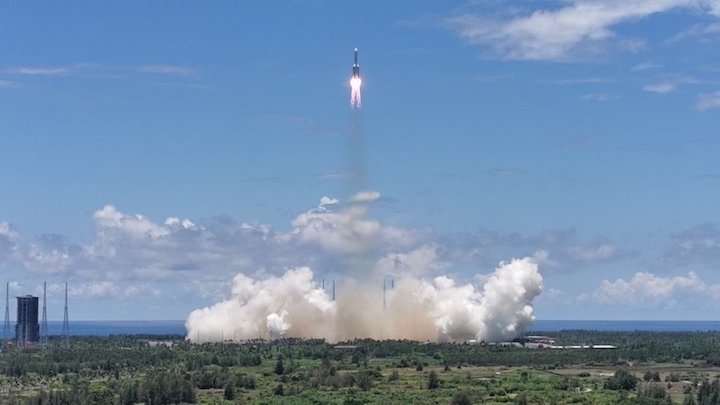
A heavy-lift Long March 5 rocket propelled China’s first Mars landing mission toward the Red Planet on Thursday after launching from a seaside spaceport on Hainan Island, the second of three international Mars probes expected to depart planet Earth this month.
Kicking off a nearly seven-month journey, China’s Tianwen 1 spacecraft lifted off from the Wenchang Space Launch Center in southern China’s Hainan province at 12:41 a.m. EDT (0441 GMT; 12:41 p.m. Beijing time) on top of a Long March 5 rocket, the heaviest launcher in the country’s inventory.
A live video feed streamed by amateur spectators near the launch site showed the Long March 5 rocket climbing away from the Wenchang spaceport. Ten rocket engines fueled by kerosene and liquid hydrogen powered the 187-foot-tall (57-meter) Long March 5 into a sunny midday sky, and the rocket quickly receded from view in the unofficial online video feed.
Chinese state media did not broadcast the mission live or publicize the exact launch time in advance, but airspace and maritime notices warning pilots and sailors to steer clear of downrange drop zones suggested the Long March 5 was scheduled to lift off Thursday.
Chinese authorities lifted the news blackout on the launch once the 11,000-pound (5-metric ton) Tianwen 1 spacecraft was injected onto a trajectory toward Mars by the Long March 5’s second stage. The China National Space Administration confirmed the Long March 5 rocket placed Tianwen 1 on the proper course toward Mars about 36 minutes after launch.
The China Aerospace Science and Technology Corp., the government-owned prime contractor for China’s space program, declared the launch a success in a statement.
Tianwen 1 is scheduled to arrive at Mars next February after a seven-month voyage. If successful, the mission will be China’s first probe to enter orbit around another planet.
Two-to-three months later, the Tianwen 1 orbiter will release a lander to enter the Martian atmosphere and aim for a controlled touchdown in Utopia Planitia, a broad plain in Mars’s northern hemisphere. Once on the surface, the lander will lower a ramp and a 529-pound (240-kilogram) rover will drive onto the surface.
If China pulls off those feats according to plan, they will make China the third country to perform a soft landing on Mars — after the Soviet Union and the United States — and the second country to drive a robotic rover on the Red Planet.
NASA has landed the only successful rovers on Mars to date.

The seemingly flawless launch Thursday by the Long March 5 rocket gives China’s most powerful launcher an 80 percent success record after five flights. The Long March 5 failed on its second test flight in 2017, but has now logged three consecutive successes.
Tianwen 1 is China’s next leap in solar system exploration after a series of progressively complex robotic expeditions to the moon.
Most recently, China has landed two rovers on the moon, including the first to explore the surface of the lunar far side. The next Chinese lunar mission, named Chang’e 5, is scheduled for launch on a Long March 5 rocket late this year on a mission to return samples from the moon.
China officially started development of the Mars mission in 2016.
It will be the country’s second attempt to reach Mars with a robotic probe, following the Yinghuo 1 orbiter, which was stranded in Earth orbit after launch as a piggyback payload on Russia’s failed Phobos-Grunt mission.
“Benefiting from the engineering heritage of China’s lunar exploration program, the Chinese national strategy set Mars as the next target for planetary exploration,” wrote Wan Weixing, chief scientist of China’s Mars exploration program, in a paper published this month by the science journal Nature Astronomy. “China’s first Mars mission is named Tianwen 1, and aims to complete orbiting, landing and roving in one mission.”
Wan died in May after a long illness.
Chinese officials announced the Tianwen name for the country’s planetary missions in April. The name Tianwen comes from the work of ancient Chinese poet Qu Yuan, meaning “quest for heavenly truth,” according to the China National Space Administration, or CNSA, the country’s space agency.
“The country’s first Martian probe will conduct scientific investigations about the Martian soil, geological structure, environment, atmosphere, as well as water,” CNSA said in a statement.
After reaching Mars in February, the Tianwen 1 spacecraft will initially enter a long-period capture orbit around the Red Planet. The orbiter will eventually settle in a loop around Mars ranging between 165 miles (265 kilometers) and nearly 7,500 miles (12,000 kilometers) over the Martian poles.
As soon as next April, the lander and rover modules will detach from the orbiter to begin a descent through the Martian atmosphere. Radar soundings from orbit have indicated the presence of a reservoir of ice containing as much water as Lake Superior, the largest of the Great Lakes, in the Utopia Planitia region targeted by Tianwen 1’s lander.

The Tianwen 1 orbiter is designed to operate for at least one Martian year, or about two years on Earth. The solar-powered rover, fitted with six wheels for mobility, has a life expectancy of at least 90 days, Chinese officials said.
Chinese scientists say the Tianwen 1 mission will perform a global survey of Mars, measuring soil and rock composition, searching for signs of buried water ice, and studying the Martian magnetosphere and atmosphere. The orbiter and rover will also observe Martian weather and probe Mars’s internal structure.
The orbiter’s seven instruments include a:
- Medium-Resolution Camera
- High-Resolution Camera
- Mars-Orbiting Subsurface Exploration Radar
- Mars Mineralogy Spectrometer
- Mars Magnetometer
- Mars Ion and Neutral Particle Analyzer
- Mars Energetic Particle Analyzer
The Tianwen 1 rover is cocooned inside a heat shield for a fiery descent to the Martian surface. After releasing from the orbiter mothership, the lander will enter the Red Planet’s atmosphere, deploy a parachute, then fire a braking rocket to slow down for landing.
“Tianwen 1 is going to orbit, land and release a rover all on the very first try, and coordinate observations with an orbiter,” Wan, the late chief scientist for China’s Mars program, wrote in Nature Astronomy. “No planetary missions have ever been implemented in this way. If successful, it would signify a major technical breakthrough.
“Scientifically, Tianwen 1 is the most comprehensive mission to investigate the Martian morphology, geology, mineralogy, space environment, and soil and water-ice distribution.”
The rover’s six science payloads include a:
- Multispectral Camera
- Terrain Camera
- Mars-Rover Subsurface Exploration Radar
- Mars Surface Composition Detector
- Mars Magnetic Field Detector
- Mars Meteorology Monitor
The rover’s ground-penetrating radar would be one of the first science instruments of its kind to reach the surface of Mars. NASA’s Perseverance rover carries a comparable instrument to scan subsurface layers of the Martian crust in search of water ice deposits.
Tianwen 1 is a Chinese-led project, but scientists and support teams from several countries have agreed to provide assistance on the mission.
Scientists from the Institut de Recherche en Astrophysique et Planétologie, or IRAP, in France contributed to a Laser-Induced Breakdown Spectroscopy instrument on the Tianwen 1 rover.
French scientists, with support from the French space agency CNES, provided guidance to their Chinese counterparts on the spectroscopy technique, which uses a laser to zap a pinhead-size portion of a rock, and a spectrometer to analyze the light given off by plasma generated by the laser’s interaction with the rock’s surface.
The technique allows an instrument to determine the chemical make-up of rocks on Mars.

The discussions between French and Chinese scientists were intended to “maximize the quality of the data” produced by the Tianwen 1 rover, according to Agnes Cousin, a planetary scientist at IRAP who worked with Chinese researchers developing the rover’s instruments.
French scientists from the same research institute helped develop the ChemCam instrument on NASA’s Curiosity rover and the SuperCam payload set for launch July 30 on NASA’s Perseverance Mars rover. ChemCam and SuperCam use the same Laser-Induced Breakdown Spectroscopy technique as the Tianwen 1 rover.
Researchers from France provided a norite calibration target to fly on the Tianwen 1 rover. It’s similar to a unit on NASA’s Curiosity rover used to calibrate ChemCam’s measurements by turning the instrument on a target — like the rock norite — with a known composition.
The SuperCam instrument on NASA’s Perseverance rover will us a different type rock as a calibration target, but Cousin said scientists at her lab in France will still be able to cross-calibrate measurements from Curiosity, Perseverance, and the Tianwen 1 rover.
Scientists from the Space Research Institute at the Austrian Academy of Sciences assisted in the development of the magnetometer on the Tianwen 1 orbiter and helped calibrate the flight instrument.
Argentina is home to a Chinese-owned deep space tracking antenna that will be used to communicate with Tianwen 1 after launch. The European Space Agency has agreed to provide communications time for Tianwen 1 on its own worldwide network of deep space tracking stations, and help with the probe’s navigation on the journey to Mars.

The launch of the Tianwen 1 Mars mission Thursday occurred less than four days after the launch of the Hope Mars probe developed by the United Arab Emirates, and a week before NASA’s Perseverance Mars rover is scheduled for blastoff.
The ever-changing positions of the planets only allow for missions to make a direct trip from Earth to Mars once every 26 months or so. The Mars launch window opened this year in mid-July and extends until mid-August.
While NASA and U.S. scientists are aiding the UAE’s Hope Mars orbiter, NASA has no such role on China’s Tianwen 1 mission. NASA’s Deep Space Network, which provides tracking and communications coverage for numerous U.S. and international space probes, has not been called up to support Tianwen 1’s voyage to Mars.
Instead, China is using a combination of its own tracking antennas and ESA’s global network of ground stations.
NASA Administrator Jim Bridenstine congratulated China on the successful launch Thursday.
“With today’s launch, China is on its way to join the community of international scientific explorers at Mars,” Bridenstine tweeted. “The United States, Europe, Russia, India, and soon the UAE will welcome you to Mars to embark on an exciting year of scientific discovery. Safe travels Tianwen-1!”
China's fastest rocket carries deep space dream
A Long March-5 rocket blasted off Thursday at the Wenchang Spacecraft Launch Site in south China's Hainan Province, carrying the country's Mars probe, Tianwen-1.
It is the first time that the Long March-5 carrier rocket, currently China's largest launch vehicle, is put into practical use after a series of trial launches.
It is also the first time the Long March-5 exceeded the second cosmic velocity, the fastest China's carrier rockets have gone to date, said Li Dong, the rocket's chief designer at the China Academy of Launch Vehicle Technology (CALVT).
The rocket did not separate from Tianwen-1 until it accelerated to over 11.2 km per second, the second cosmic velocity or escape velocity. At that speed, Tianwen-1 went into the Earth-Mars transfer orbit, overcoming the gravitational pull of Earth and embarking on an interplanetary journey, Li explained.
The rocket, codenamed Long March-5 Y4, has a total length of almost 57 meters, equivalent to the height of a 20-story building. It has a 5-meter-diameter core stage and four 3.35-meter-diameter boosters.
The rocket uses environment-friendly propellants, including liquid oxygen, liquid hydrogen and kerosene. It has a takeoff mass of 869 tonnes and can carry a payload of 14 tonnes to a geostationary transfer orbit.
As the relative positions of Earth and Mars are constantly changing, a space mission from Earth is like shooting at a moving target. The researchers have designed a record number of trajectories targeting multiple narrow time windows to ensure the probe's precise entry into the preset orbit, said Wang Jue, general director of the rocket research team at CALVT.
The Mars mission has a 30-minute launch window each day for 14 consecutive days from late July to early August. The rocket team subdivided it into three 10-minute launch windows with different trajectory parameters, said Wang Jue.
A total of 42 launch trajectories have been designed, more than any other Chinese space mission and the rocket can switch among them automatically, Wang Jue said.
Tianwen-1, comprising an orbiter, a lander and a rover, weighs nearly five tonnes, a tonne heavier than the Chang'e-4 lunar probe. It is the heaviest deep space probe that China has launched so far.
"Relying on the strong carrying capacity of the Long March-5, China will push its deep-space exploration from the moon to the planets," said Li Minghua, top director of the Long March-5 team at CALVT.
Previously, the Long March-5 successfully launched the Shijian-20 satellite. The Long March-5B carrier rocket, a modified version, sent China's new-generation manned spaceship for test into space.
Based on the experience of these launches, engineers have improved the technology and reliability of Long March-5 Y4, covering multiple systems like its control system, measuring system, body structure, and ground support system. Enditem
Quelle: Xinhua
+++
China successfully launches first Mars mission

China launched a Mars probe on Thursday, designed to complete orbiting, landing and roving in one mission, taking the first step in its planetary exploration of the solar system.
A Long March-5 rocket, China's largest launch vehicle, carrying the spacecraft with a mass of about 5 tonnes, soared into the sky from the Wenchang Spacecraft Launch Site on the coast of southern China's island province of Hainan at 12:41 p.m. (Beijing Time).
About 36 minutes later, the spacecraft, including an orbiter and a rover, was sent into the Earth-Mars transfer orbit, embarking on an almost seven-month journey to the red planet, according to the China National Space Administration (CNSA).
China's first Mars mission is named Tianwen-1, which means Questions to Heaven and comes from a poem written by Qu Yuan (about 340-278 BC), one of the greatest poets of ancient China. The name signifies the Chinese nation's perseverance in pursuing truth and science and exploring nature and the universe, said the CNSA.
"The successful launch is only the first step of China's Mars mission, and we hope each of the many key steps of the long journey is completed successfully," said Geng Yan, an official at the Lunar Exploration and Space Program Center of the CNSA.
The key steps include slowing down when close to Mars, orbiting, separating the landing platform and the rover from the orbiter, landing softly and roving.
The craft is expected to enter the orbit of Mars around February 2021. Afterwards, it will spend two to t


